Lea Wait's Blog, page 35
July 10, 2024
My Summer Projects!

Vaughn C. Hardacker
It has been a long time since I posted a blog, and I think my prolonged absence has contributed to my inability to write much. For quite a while, my muse seems to be on sabbatical. I’m hoping that this post, which is intended to (I hope) get me back into a writing routine. So here is my excuse(s)–as we all know, excuses always sound good to those who make them.
As many of you know, I live In Stockholm in Aroostook County (halfway between nowhere and even less). As a resident of Maine’s northernmost county, I am always asked what it is like living here. I usually reply: “It’s not so bad … we have nine months of winter (September through May) and three months (June, July, and August) to prepare for it. I also live in a house that is almost one-hundred-twenty-five years old. Here’s a sample of what my three months of preparation have been like.
As I stated, my house was built in 1900 before modern-day materials such as pressure-treated wood and lumber were not planed as they are today. For example, when you

332 Main Street
Stockholm, Maine
purchase a 2X4 piece of lumber, it is, in reality, about 1 3/4″ by 3 1/2″. In 1900, it was unplaned and 2″ by 4″. What does this have to do with anything? There is a farmer’s porch (the house used to be a boarding house when Stockholm was a growing lumber town–picture a bunch of old timers sitting on the porch watching the trains come and go) on the house, and 1/3 of it was so rotten that you could crumble the wood with your hands! In the above picture, it was the section on the right. For several years now, I spent my winters waiting for the roof to collapse. Last year, I decided to do something about it. I contacted several carpenters and asked for bids to replace the rot and firm the porch. I got quotes of $53,000.00 and $12,000.00, and one contractor said, “I’ll have a bid for you in two weeks.” (We’re still waiting for that bid). The point is to save money. We have mixed 1900-era lumber with 2000-era lumber, and due to the differences cited above, I need to plane the boards to level the deck and remove trip hazards (or I can put up signs requesting that people lift their feet when walking rather than shuffling them).
Last November, my partner Jane and I were at a dance at the VFW; she still smokes and goes outside for a cigarette. When she returned, she was accompanied by a man about my age (better known as an old fart). “This is Phil,” she said, “he’s willing to look at the porch and give us a quote.” To get to the point, Phil and I met in the spring, and he looked at the porch. He said, “If you want to work with me, I can save you some money.” I replied that was my intention all along. He then gave me his requirements “I charge $50.00 an hour. I’m 75 years old and only work 4 or 5 hours a day. You purchase the material. I think we can do this in two weeks, depending on what we find when we get underneath.” We agreed.
Phil showed up every morning around 6:00 AM and worked until 11:00 AM. After he left, I worked all afternoon cleaning up all the old rotten material and running to the lumber yard for materials. I’m not a spring chicken anymore, and by evening, I hurt in places I didn’t know existed! I have to mention what it was like working with Phil… It was like working with me. He’d moan and argue with himself and curse and sputter when things didn’t go well. He kept apologizing and telling me he wasn’t upset with me or my lack of carpentry skills. It is just his way of venting and dealing with frustration. I laughed and told him the truth: “I do the same thing … I tend to hold myself to standards that God can’t keep! I was married to my late wife for 35 years, and I had an hour commute one way to work. Many a time when I was upset with Connie, I’d practice my argument while I drove through Boston traffic (people must have thought I was a potential serial killer as I talked and yelled at no one as I drove). That commute probably saved my marriage. By the time I arrived home, I’d said everything I wanted to say and was argued out. Result? No argument at home. Phil and I are soul mates in that regard.
Ultimately, when we finished the job, it cost me less than $5,000.00. That is how the first two weeks of June went. A week ago, Jane decided she wanted an above-ground pool. At Walmart, she found one that was listed as an 18-foot pool and purchased it. I assumed it wouldn’t be too bad. Our yard is as level as the sand dunes in the Sahara Desert after a wind storm. So, we ordered three yards of sand to level off an area to put the pool. I measured an area based on a circumference of 18 feet, and we spent a day and a half spreading the sand to make the ground level. Then we put the pool together. A circumference of 18 feet would have a diameter of 18 divided by pi (3.14). Well, the pool diameter was 18 feet! A circle with an 18-foot diameter has a circumference of 18 times pi! Or approximately 56.55 feet! Guess what I’m doing for the rest of the summer.
I have promised Jane that she’ll be able to use it next summer!
July 10, 2024 Addendum.

Our 18′ Pool!
The pool is finished! It is up, level, and filled with water! The photo to the left is proof. We can finish the landscaping at our leisure, maybe next summer. After all, pool season in The County is July and August. We own the largest ice cube in Aroostook County from September through June. Who says there’s nothing to do up here in the County?
July 9, 2024
Just thinking about THEME
blogged by JULE SELBO

This week I was a guest on Steven Jame’s podcast: The Story Blender. It’s a weekly podcast for authors, storytellers, comedians, actors and filmmakers. I met Steven at ThrillerFest, we were on the same panel, assigned to talk about STORY. He’s written over a dozen crime/mysteries, including the Patrick Bower series and the Travis Brock thrillers – as well as two books on the ART of writing fiction.
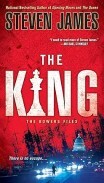 What writer ever tires of talking about construction of STORY? And talking about if PLOT and STORY are totally different animals? Or talk about what – in crime mysteries – is most “wanted” by the reader – a CHARACTER ARC or focus on the ENGAGING PUZZLE of clues and red herrings, obstacles, dead bodies and danger.
What writer ever tires of talking about construction of STORY? And talking about if PLOT and STORY are totally different animals? Or talk about what – in crime mysteries – is most “wanted” by the reader – a CHARACTER ARC or focus on the ENGAGING PUZZLE of clues and red herrings, obstacles, dead bodies and danger.
Like a lot of panels at the writer conferences, there were four us talking about the subject. Tom Straw (famous for the Richard Castle series (which he wrote under the pseudonym Richard Castle and then there ws the tv show – he’s written other books also) joined us too
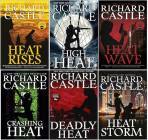 and Boyd Morrison (he writes novels solo – as well as with his sister Beth – as well as with Clive Cussler) and we danced around personal definitions, how we make sense of STORY in our own heads, how aware we are that it’s often semantics and not disagreement of how to use STORY while preparing or executing a crime/mystery.
and Boyd Morrison (he writes novels solo – as well as with his sister Beth – as well as with Clive Cussler) and we danced around personal definitions, how we make sense of STORY in our own heads, how aware we are that it’s often semantics and not disagreement of how to use STORY while preparing or executing a crime/mystery.

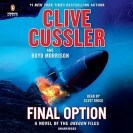

Steven and I realized we were two birds of the same feather. We both have a deep love of movies, tv series, have written screenplays – as well as love to talk story, plot, characters and nitty-gritty things like sentence structure, paragraph structure, length of chapters, theme, dialogue, minutiae and the big picture. So when he invited me to be on his podcast I thought – great – a place to continue our conversation.
During the podcast, Steven and I got on a micro-tangent about THEME in crime/mysteries. For some reason (in the semantics lightbulb going off in my head), the exploration of theme began to line up with the idea of DILEMMA. I tend to appreciate stories with small or large character arcs – (some coming-of-age component, some tiny or massive maturation) – and when Steven and I discussed DILEMMA, we circled around how THEME might have a correlation to the interior dilemma the protagonist is facing – and how facing the dilemma can lead to that interior growth (character arc).
 Yeah yeah. More semantics. But no matter if we landed on the absolute correct words or if the off-the-cuff connection we explored might hold up in a longer examination – it’s been helpful to me as I navigate through the final chapters of 7 DAYS, A Dee Rommel Mystery (4th in the series). And as I re-read the beginning and middle chapters of 7 DAYS to make sure the through-line of the main investigations and the personal stories were holding together I kept that word in mind: Dilemma.
Yeah yeah. More semantics. But no matter if we landed on the absolute correct words or if the off-the-cuff connection we explored might hold up in a longer examination – it’s been helpful to me as I navigate through the final chapters of 7 DAYS, A Dee Rommel Mystery (4th in the series). And as I re-read the beginning and middle chapters of 7 DAYS to make sure the through-line of the main investigations and the personal stories were holding together I kept that word in mind: Dilemma.
I don’t know about you, but THEME rises to the top for me as I work on a project. I can’t write to theme. I don’t have a sermon inside me waiting to come out. But as a Dee Rommel book progresses, I start to realize that my private investigator Dee (a woman who needs a lot of coming-of-age moments to (hopefully) realize her full potential) is taking the events of the plot and internalizing them in relation to her most recent and prevalent character dilemma. Just this morning I realized (yeah, like I said, I’m in the final chapters) that her fear of not having family, of losing someone very important in her life, is affecting all the past and new relationships she deals with in the investigation. Almost like she’s pushing people away to prove to herself she doesn’t need anyone. Or is it that she’s pushing so hard because she wants deeper commitment, but can’t help wondering if anything will be deep enough to replace the significant losses in her life?

7 DAYS, still in progress. But I love this moment. When I can go back through the pages and shape the STORY just a little bit – to allow THEME to be hinted at. Keep it always subliminal – but let it be there.
July 8, 2024
Cellphones and Crime

Cellphones. How important are they in our society? Everywhere we look people are on their phones. Entire families sit in restaurants and stare down at their phones, not interacting with one another, playing games or texting friends. People cross the street staring down at their screens, oblivious to the traffic around them. Just think how much life has changed since the advent of the cellphone.
One important way is how law enforcement uses phones to solve crimes. Cellphones have become a necessary and important part of crime investigations. They contain valuable forensic information that allows law enforcement to reach certain conclusions. On the flip side, cellphone data can help clear innocent people of crimes, and help narrow down suspects.
One of the apps on people’s phone is called Life360. Here is the description of Life360 on the App page. “Elevate safety for family and friends with Life360, the trusted family safety location-sharing app with over 50 million members worldwide. Our comprehensive app simplifies safety, offering Real-Time Location Sharing, Crash Detection, SOS Alerts, Roadside Assistance, Identity Theft Protection, and so much more. Stay connected with your loved ones effortlessly and track valuable belongings seamlessly at home, on the road, and on the go.”
This app is extremely valuable to law enforcement when conducting an investigation. Assuming they get a search warrant for the person’s phone, law enforcement can track an individual’s movements and see if they were at the crime scene at the time of the crime. In the Alex Murdaugh trial, the police used time logs to pinpoint the time of the murder. In the case against Karen Read, which ended in a mistrial, the victims health data showed him to have walked up a flight of stairs and into the house, despite the prosecution saying he’d never entered the house. Another key point came when a witness claimed to have seen Karen Read’s car in front of the house at 12:35 a.m. The only problem with this testimony is that Karen had connected her phone to her boyfriend’s WiFi at 12:36 a.m. and that was six minutes away.
Forensic experts can now track call data and see when calls where made and if they were answered and deleted. They are also able to see what was typed in text messages. The most common forensic software used by law enforcement is call Cellebrite. “Cellebrite is an Israeli digital intelligence company that provides tools for federal, state, and local law enforcement as well as enterprise companies and service providers to collect, review, analyze and manage digital data.” Cellebrite is one of the most important tools for police and prosecutors as far as finding the true culprit.
Forensic phone data is an important tool for both law enforcement and for finding the truth of a criminal matter. For criminals the advice is simple: if you’re going to commit a crime, leave your phone at home.

July 5, 2024
Weekend Update: July 6-7, 2024
 Next week at Maine Crime Writers there will be posts by Joe Souza (Monday), Jule Selbo (Tuesday), Vaughn Hardacker (Thursday) and Rob Kelley (Friday).
Next week at Maine Crime Writers there will be posts by Joe Souza (Monday), Jule Selbo (Tuesday), Vaughn Hardacker (Thursday) and Rob Kelley (Friday).
In the news department, here’s what’s happening with some of us who blog regularly at Maine Crime Writers:
Kathy Lynn Emerson is participating in the Smashwords annual Summer/Winter sale. All her reissued and indy published fiction and nonfiction ebooks will be 25% off, at Smashwords only, for the entire month of July. Here’s a link to the multi-page list of what’s available:
https://www.smashwords.com/books/search?query=Kathy+Lynn+Emerson
Maine Crime Writers John Clark, Maureen Milliken, Vaughn Hardacker, and Kate Flora will be at the Topsham, Maine library on July 9th for this event:
JULY 9, 2024 • 6:00 PM – 7:00 PM • JULY 9, 2024
Casting Call with Maine Crime WritersThis panel explores the way different writers choose the attributes of their principal characters, the victim, the sleuth, and the villain, along with those additional characters such as sidekicks, alternative suspects, witnesses, and others, who are needed to fill out the cast. The panelists are John Clark, Kate Flora, Vaughn Hardacker, and Maureen Milliken of Maine Crime Writers. For more info about them visit their blog at mainecrimewriters.com
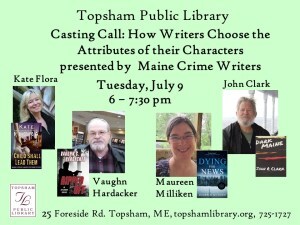
Love chatting with our local crime writers? Matt Cost, Kate Flora, and Maureen Milliken will be at the Brunswick Second Friday Art Walk and the Bath Third Friday art bops this summer. Stop by and say hello.
An invitation to readers of this blog: Do you have news relating to Maine, Crime, or Writing? We’d love to hear from you. Just comment below to share.
And a reminder: If your library, school, or organization is looking for a speaker, we are often available to talk about the writing process, research, where we get our ideas, and other mysteries of the business, along with the very popular “Making a Mystery” with audience participation, and “Casting Call: How We Staff Our Mysteries.” We also do programs on Zoom. Contact Kate Flora
Hello Mudda, Hello Fadda, This Place Sure Beats Camp Granada

YOU tell them there’s no such thing as a free lunch.
John Clark reporting in after a most satisfying trip. Back in January, Beth suggested it might be fun to take Piper, our older granddaughter, on an educational adventure this summer. We decided on a Road Scholar program called Ocean Science Adventures on Chincoteague Bay With Your Grandchild, With assistance in planning from AAA, we set off two weekends ago, driving to Portland and catching a bus to South Station in Boston. We took AMTRAK from there to Washington DC, rode the Metro to Reagan Airport and then rented a car. We stayed overnight at a hotel in Easton, MD where Beth and Piper took advantage of the swimming pool in the morning, having it all to themselves.

Some of the sea creatures we caught in the net.
The drive to Wallops Island took us through lots of farm country. I’m convinced Maryland has more Turkey Vultures than all of New England combined. I don’t think there was a moment where we couldn’t see at least one soaring overhead.
We arrived with a couple hours to kill before check-in, so we drove out to the beach on Assateague Island. While being crowded, there was plenty of room to wander the beach and for Piper and Beth to wade in as far as they wanted. It was a perfect beach day and we got our first glimpse of the famed ponies on our way back. The road between Wallops and Chincoteague crosses a wide salt marsh that’s rife with sea birds as well as numerous blinds for birders and hunters. Beth loves herons and she got her fill on the trip as we saw several varieties almost every day.

North herd ponies
After checking in, we went to our room which had four single beds with a bathroom across the hall reserved for the three of us. We shared that part of the building with a couple from California and their granddaughter, Elizabeth who lives in Oregon. She and Piper became besties on the first full day of the program. All the kids got along extremely well with each other, playing volleyball, putting on a talent show, and showing each other new discoveries during hands-on activities. It was fun to watch them bonding and being full of happiness and excitement.

Another activity, hand netting for sea creatures in the surf.
I can’t say enough about the meals! Every one was great and plentiful. Breakfast always included scrambled eggs, accompanied some mornings by bacon or sausage. Hot oatmeal was available daily, as were several varieties of fruit. Beverage choices ranged from juice to coffee, and varied carbonated flavors on tap, as well as milk. Yogurt was also a breakfast staple. Lunch and dinner had different choices each day, ranging from grilled salmon to fried chicken, burritos. Every lunch and dinner meal included a very well stocked salad bar. Nobody went away hungry.
Our Thursday evening meal was a special experience. After seeing marine life up close all week, Molly, our extremely capable program director and her staff cooked us a boiled seafood fest of blue crab, clams, and shrimp. There were more traditional entrees for those allergic or not shellfish fans. I, however, am one who believes there is no such thing as too many shrimp. It was cooked by the staff and began with a double layer of kraft paper on top of the table. We watched while they walked along two tables, spilling seafood down the middle of each. When we sat and began to enjoy the feast, those of us who were knowledgeable about the ways of eating shellfish tutored the others in how to undress shrimp, and crack crabs. Aided by plentiful bowls of melted butter, it was a true feast.
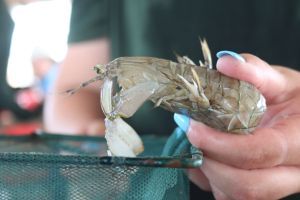
Mantis shrimp
Now for the programs. Each morning, we had an outside meeting where Molly and her crew got us moving with a singing exercise followed by the day’s schedule. On Monday, we went back to the beach on Assateague Island for a barbecue, some surf wading,and time to explore the Bateman Visitor Center where a very sharp woman entranced the kids by showing and telling them all about Hermit Crabs. The staff was up to the challenge of fending off frequent forays by Black Headed Gulls, eager to grab whatever food they could.
Other program highlights included wading through a salt marsh to get a real sense of what they’re all about. Everyone was encouraged to wear a bathing suit and old clothing because they would be in muddy conditions. I passed because my balance is getting pretty bad, but Beth and Piper went right at it. At the edge of the marsh were hundreds of fiddler crabs and can they move fast!
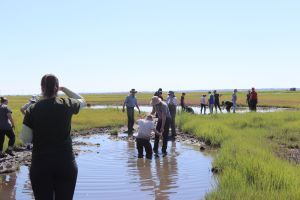
The famed marsh wade.
Everyone was psyched about seeing the famed ponies. We first saw some of the smaller southern herd while going and returning from the beach, but the staff had permission to take us on a bus along the access road to view the larger herd on the north end of the island. Some of them almost seemed to expect us as they posed for everyone to take photos. One of the staff members kept up a narrative about their history, how they are cared for, when and why the twice a year swim happens, and why the herd needs to be thinned. The work of making sure much of their care happens is done by the Chincoteague volunteer fire department. They raised upwards of $200,000 last year.
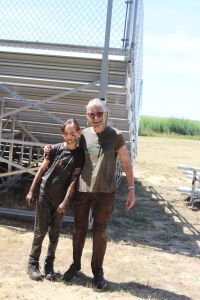
Beth and Piper, post mud
My favorite was the dredging trip on a large flat-bottom boat. Molly and her staff walked us through what we might see when each drag net was hauled up. We used the drag four times and there were two firsts for the season. We caught two stingrays and a Mantis Shrimp, which has front claws so powerful they can break glass. In addition, we caught a Toadfish, several flounder, a seahorse that gave birth right after it was placed in a tank, and a purple sea urchin. Everyone got a chance to release, or retrieve the net at least once. In addition, we used a tiny mesh net with a collection jar to get samples of plankton which we examined under a microscope in a later lab session.
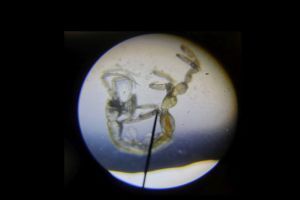
One of the plankton we captured, viewed under a microscope.
We also took a bus ride to the beach just north of NASA’s Wallops rocket launch area. There, we used what we’d learned in a lab session to create embryonic dunes, working as teams. This reinforced our classroom learning about how barrier islands and dunes are created and what their role in the environment is. Then we did some shell seeking. I looked for ones I thought Beth and Piper might want, content to do that while enjoying another long stretch of beach.
Out final evening was a social hour for the adults, followed by the kids performing a talent show. It was great fun for all. One of the other two grandfathers there grew up In Warren, moved to Pittsfield and graduated from MCI. Perhaps the most interesting person was an eighty-five year old woman who had emigrated from Burma in the 1970s. She brought her thirteen year old grandson from where they live in Oakland, California because he hadn’t had much chance to adventure and socialize since COVID. I greatly enjoyed chatting with both of them.
While long, this barely covers our adventure. If you’re looking for a way to gift your grandchildren a trip that blends learning and fun, look no further than something from Roadscholar.
Finally, a shout-out to a fellow author who was on the trip. Her first historical novel comes out later this month. Check it out at https://lindaross-author.com
July 3, 2024
Salmon and Peas Once Again
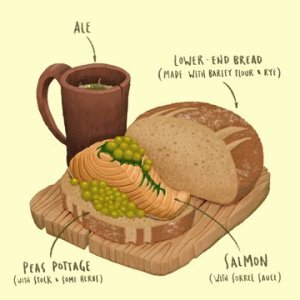 Hello dear blog readers, and happy Independence Day to you.
Hello dear blog readers, and happy Independence Day to you.
It’s been a busy couple of weeks in my life so I’m following the footsteps of my colleague Kate Flora’s by re-running a favorite post today. This was written on the Fourth of July two years ago, and it feels even more relevant and important now as it was then.
Restoration of the Presumpscot River is only one example that illustrates the words attributed to Margaret Mead quoted below. Her observation is my inspiration and motivation this July 4.
Working together, we can protect our land and water, address the very real threats of our warming planet and preserve our democracy. So let’s get to work, individually and collectively. We owe it to our forebearers and our children.
Posted on July 7, 2022
I’m writing this on the Fourth of July, a day to think about both the founding and current state of our nation.
Dinner will be salmon and peas, a culinary tradition I’ve adopted in adulthood. When I was a child, the holiday repast involved hotdogs and hamburgers, potato salad and ice cream. But these days we eat more fish than meat, and we have made it our ritual to eat salmon, new potatoes and peas on Independence Day, as the early settlers of New England did.
Eating local was the only option in the early days of this country. After a winter of root vegetables and dried, salt-cured meat, a Fourth of July meal of fresh fish with just-picked peas and newly dug potatoes must have been a celebration indeed. At that time, the summer salmon migration upriver from the Atlantic Ocean provided an abundance of protein-rich fish, so it’s no surprise salmon on the Fourth became a traditional meal throughout the region.
The habitat for Atlantic salmon was undermined beginning in the middle of the eighteenth century when industrialization led to rivers across New England being dammed to provide power to the mills along their banks. It either didn’t occur to the dam builders that the river-spanning monoliths would harm the native fish population or they didn’t care, but blocking the rivers prevented sea-run salmon from reaching their spawning grounds.
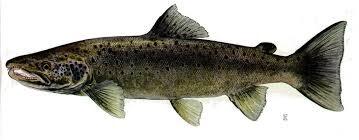
In addition, until implementation of the Clean Water Act, industrial pollution degraded the water quality to the point that the populations of wild salmon and many other fish species pretty much collapsed. In 2022, Maine is the only state that still has a population of Wild Atlantic salmon, but its endangered status puts it off limits to both the commercial and recreational fishery.
However, as the cultural anthropologist Margaret Mead is reported to have said, “never doubt that a small group of thoughtful, committed citizens can change the world; indeed, it’s the only thing that ever has.” In recent decades, small groups of committed citizens have dedicated themselves to dam removal and the restoration of water quality in Maine’s rivers, a fact that gives me hope in these days when it is in short supply.
The Presumpscot runs through my community of Westbrook,  and it’s a different river today than it was in the mid-1990s, when a concerted restoration effort began. The Friends of the Presumpscot River, the Coastal Conservation Association, the National Fish and Wildlife Foundation and the Conservation Law Foundation, as well as government entities such as the Army Corps of Engineers, the Maine Department of Marine Resources and the U.S. Fish & Wildlife Service have collaborated since that time on reviving the Presumpscot and its wild salmon fishery. The story of their work is captured in this article: https://www.fws.gov/story/rallying-round-presumpscot
and it’s a different river today than it was in the mid-1990s, when a concerted restoration effort began. The Friends of the Presumpscot River, the Coastal Conservation Association, the National Fish and Wildlife Foundation and the Conservation Law Foundation, as well as government entities such as the Army Corps of Engineers, the Maine Department of Marine Resources and the U.S. Fish & Wildlife Service have collaborated since that time on reviving the Presumpscot and its wild salmon fishery. The story of their work is captured in this article: https://www.fws.gov/story/rallying-round-presumpscot
Appreciation for the river—its history, its natural resource values and its future potential—informs the common commitment of those who are involved in this important work. To me, the mix of volunteer and governmental organizations on this list is particularly powerful.  Since the 1970s, enormous strides have been made to clean up our water and air, and the most far-reaching and enduring results have been when governmental agencies have coordinated and worked cooperatively with groups of citizen volunteers dedicated to protecting and preserving treasured places and precious water bodies.
Since the 1970s, enormous strides have been made to clean up our water and air, and the most far-reaching and enduring results have been when governmental agencies have coordinated and worked cooperatively with groups of citizen volunteers dedicated to protecting and preserving treasured places and precious water bodies.
Last week the US Supreme Court showed itself to be out of step with this thinking. In West Virginia v. Environmental Protection Agency, a 6- 3 court ruled the EPA does not have authority to regulate power plant emissions. The case was about clean air, but the ruling will almost certainly have implications on clean water efforts and many other environmental initiatives. Unless Congress acts, the EPA’s role and resources will be curtailed.
What can you do if you want to be sure not only you but future generations will be able to access Maine rivers for fishing, boating, hiking, birdwatching or any other environmentally sustaining purpose?
Join and support volunteer organizations in your area dedicated to the health and vitality of Maine’s rivers. For those who live near the Presumpscot River, information about educational programs and volunteer opportunities can be found here: https://www.presumpscotriver.org/Contact your Congressional representatives about the value of Maine rivers and the need to protect them with laws that specifically grant to regulatory agencies the authority to implement environmentally positive policies such as emissions controls and dam removal. If you need some talking points, check out this video: https://www.presumpscotriver.org/blog/2018/5/6/tales-of-the-presumpscot-healthy-rivers-healthy-oceansAsk my blogmates Richard Cass and Sandra Neily for their ideas about effective action. Dick is a lifelong fly fisherman and Sandy is an expert at that, too. They know more about Maine Rivers that I ever will and I’m sure they have plenty of suggestions.Register to vote. If you’re registered already, encourage those in your life who are not registered to do so.Vote like the quality of your life depends on it. Because it does.Brenda Buchanan brings years of experience as a journalist and a lawyer to her crime fiction. Her three-book Joe Gale series features a Maine newspaper reporter who covers the crime and courts beat. Her short story, MEANS, MOTIVE, AND OPPORTUNITY, received an honorable mention in Best American Mystery and Suspense 2022. This Fourth of July, Brenda’s hard at work on a new novel. FMI, go to http://brendabuchananwrites.com
SEA KAYAKING – PURE JOY!
Charlene D’Avanzo: I love lots of sports – swimming, hiking, jogging, skiing, biking, and more – but for me nothing beats the delight of sliding into my sea kayak, pushing off, and floating away from shore. I literally leave all terrestrial troubles behind and for an aquatic few hours revel in the watery world below and all around me.
There’s so much to see! Schools of fish startled by my boat’s shadow dart off to safety, seaweed sways back and forth with the current, a startled family of ducklings quacks away, an eagle high in a tree on shore tips its head and checks me out.
Too soon I must turn around and return to shore – the tide has changed and my earthly duties are calling. But I’ll be back – maybe not tomorrow but soon, very soon.

July 2, 2024
Imagination, Revisited and Happy Anniversary to Us
Kate Flora: For those who haven’t been following us for many years, July is the month when this blog was born. July 11th, as I recall, but I could be off by a few days. Our initial blog group included Julia Spencer Fleming, Gerry Boyle, Paul Doiron, Jim Hayman, Sarah Graves and others. Over the years, writers have come and gone, but the idea: for a group of Maine crime writers to blog about all things writing and all things Maine, has persisted.
when this blog was born. July 11th, as I recall, but I could be off by a few days. Our initial blog group included Julia Spencer Fleming, Gerry Boyle, Paul Doiron, Jim Hayman, Sarah Graves and others. Over the years, writers have come and gone, but the idea: for a group of Maine crime writers to blog about all things writing and all things Maine, has persisted.
Today I was going to write about my rapidly approaching 75th birthday and the challenges of facing that in a thoughtful manner. Instead, I started musing about all the years I’ve been blogging here, and stumbled on this very early post (it may have been my first) about imagination. Since today is such a glorious day on the coast of Maine, and since summer offers so many opportunities to use our imaginations to store up writing ideas for the long, cold winter (as mom used to say about canning and freezing), I am resharing it here.
A few years ago, at one of those A-list parties where I was surrounded by some of those “famous” authors whose books are on all our shelves, I was working on an assignment to write a column for a magazine. The topic was “IMAGINATION,” so I asked several of the authors what came to mind when I said “imagination.” You’d think I’d said a dirty word. Some were silent. Some pondered as though I’d asked a trick question. A few offered uncertain answers, suggesting the realm of fancy and fantasy, or something dark or New Age. Not one responded as I’d expected, shrugging their shoulders and stating the obvious. “Imagination? Heck, we’re writers. Imagination is our principal tool.”
Recently, I tried the same question with some of my Facebook friends and got some great responses. Among them:
Albert Einstein’s quote: “Imagination is more important than knowledge.” PJ Schott
A person, attached to a bunch of multi-colored balloons that are pulling her up into the bright blue sky. Vicki Lane
When my son was small, we took him to NASA. He played and played on all the science stuff and adored it all. When we finally dragged him out to the car and began to buckle him into his car seat, he told me, “Mommy, I think I’ll take a nap now. My imagination is tired.” Julie Wray Herman
It’s actually kind of a loaded word for me because when I was a kid I was always told I had a “wild imagination” and that I was too much of a dreamer. But now imagination means my private world populated by all the fascinating characters who want to be in my stories. Kathleen Valentine
Lots of company in my head. And the ability to scare myself sh*tless. Edith Maxwell
Fun, to play with images and words. Being able to create my own images to go with the writer’s words. The ability to create stories that make others feel what I want them to feel. Nancy Myer
Ursula K. LeGuin’s sentence: “Imagine darkness.” The first sentence and paragraph of CITY OF ILLUSION. Tom Carollo
Imagine. That’s what the writers here do. Every day. All the time. Sometimes we’re scared sh*tless.  Sometimes our ideas soar like balloons, lifting us up into the bright blue sky. Sometimes our imaginations do run wild and have to be reined in; other times, like horses that need to be given their heads, we need to set them free to wander where our more cautious natures might not go, because we’re following characters who are not us, who may be braver, wickeder or more willful and headstrong than ourselves. Characters we’ve imagined into life but who are often radically different from us. Characters who, if we’ve imagined them fully and well, may even begin to do things we didn’t plan for them to do.
Sometimes our ideas soar like balloons, lifting us up into the bright blue sky. Sometimes our imaginations do run wild and have to be reined in; other times, like horses that need to be given their heads, we need to set them free to wander where our more cautious natures might not go, because we’re following characters who are not us, who may be braver, wickeder or more willful and headstrong than ourselves. Characters we’ve imagined into life but who are often radically different from us. Characters who, if we’ve imagined them fully and well, may even begin to do things we didn’t plan for them to do.
As we watch our characters handle the situations we’ve put them in, we’re imagining their thoughts and feelings. How will they handle conflict? Discouragement? Relationships gone wrong? How will they react when we put them into situations that are so scary they make it hard for us to breathe? How will they master new knowledge, unsettling knowledge, someone’s refusal to disclose critical information, or receiving knowledge that doesn’t fit what they know? How will we master new knowledge so we can give it to them and then let it seem organic to who they are?
A student of mine at Grub Street, a few years ago, listened to a fellow student read her piece and then said, “It’s great. And I can see how you want me to feel. Now, make me feel it.” A challenge for his fellow student, and challenge for all us writers every day. John Gardner, in The Art of Fiction, says that what a writer does is put his dream in the reader’s head. For us to do that well, we have to imagine our places, our characters, and our characters’ emotions well enough so that when we write them, you will feel them. It’s always a challenge.
 Recently, at a Sisters in Crime members read event, one of the participants looked out the window, saw this house, and said, “There’s a story.” There’s a story wherever we look if we’re paying attention and letting our imaginations work.
Recently, at a Sisters in Crime members read event, one of the participants looked out the window, saw this house, and said, “There’s a story.” There’s a story wherever we look if we’re paying attention and letting our imaginations work.
And of course, because of what we write, whether we write traditional mysteries, historicals, serial killers, police procedurals with rookie cops or seasoned veterans, a female police chief, domestic suspense, the challenges of wayward plumbing, the dangers of selling real estate, or what it’s like to be a warden alone facing down bad guys in the Maine woods, we’re writing about the evil that men (and women do) and we are forced to imagine darkness.
Until our imaginations get tired and we need to rest and cloud watch. But wait, doesn’t that cloud look like a whale? That one a shark? The other a gigantic pile of whipped cream? It never really stops.



June 30, 2024
Story and Structure
 Kaitlyn Dunnett/Kathy Lynn Emerson here, today writing as Kathy. As I’ve mentioned before here at Maine Crime Writers, I’m in the process of editing and reissuing my Face Down mystery series, ten novels originally published between 1997 and 2007. They feature Susanna, Lady Appleton, a sixteenth-century gentlewoman who just happens to be an expert on poisonous herbs.
Kaitlyn Dunnett/Kathy Lynn Emerson here, today writing as Kathy. As I’ve mentioned before here at Maine Crime Writers, I’m in the process of editing and reissuing my Face Down mystery series, ten novels originally published between 1997 and 2007. They feature Susanna, Lady Appleton, a sixteenth-century gentlewoman who just happens to be an expert on poisonous herbs.
This is actually the second edit I’ve done on these texts. The first was for a three volume e-book collection of all the novels and short stories in the series. Although I haven’t changed the plots or characters, I keep finding plenty of places that need tweaking and/or cutting. Much of what I’ve done is to remove cumbersome language, since I’ve realized that using words like ’tis and certes don’t really give the dialogue “the flavor of the times,” but rather start to grate on the reader’s nerves—at least on this reader’s nerves. I’m also changing phrases like “I do think” to the simpler “I think” and although I know contractions were not in general use in the sixteenth century, I’m letting most of those stand. Worse problems are solved by making judicious cuts. Twenty or so years ago I was wordy (probably trying to make a pre-set word count!) and dialogue between characters didn’t always proceed in a logical fashion. Real-life conversations don’t, either, but in fiction it helps if characters’ thoughts don’t jump around quite so flagrantly.
That said, today’s topic isn’t language or syntax, but rather story and structure. Doing these revisions reminded me of the goals I had when I set out to write historical mysteries set in the sixteenth century.
I knew from the start that there was one thing I wanted to avoid. I did not want the books to be set at the royal court. This proved a wise choice, since two other series were launched at about the same time as mine, one featuring Queen Elizabeth I as an amateur sleuth and the other with a heroine who had close ties to the court. It is book eight, the one I’m currently editing, before Susanna Appleton actually visits the court, and the plot centers around her heartfelt desire not to host the queen at Leigh Abbey, the Appleton manor in Kent, when Elizabeth makes her annual progress into the countryside.

detail of monument to the Cooke sisters
What did I set out to do? A better question would be: what were my inspirations? Susanna herself was inspired by the lives of the five Cooke sisters. Their father educated his daughters as if they were boys (following the example of Sir Thomas More and others) and four of them grew up to marry prominent men and attain fame in their own right for their scholarship. Educated women were not all that rare in sixteenth-century England. (Read my A Who’s Who of Tudor Women if you want to know more) Susanna is literate and clever and developed an interest in poisonous plants—and preventing accidental poisonings—in childhood, after her younger sister died from eating banewort berries. Like one of the Cooke sisters, she marries a gentleman who has been knighted, making her Lady Appleton (see my previous blog on the subject of forms of address). She’s not royal, or even noble—just the daughter and wife of gentlemen. She copes as I imagine someone of her social standing would cope, given that she keeps encountering victims of murder.
 The conflict (a necessity in any story—right?) between Susanna and her husband, Sir Robert, was inspired by Beatrice and Benedict in Shakespeare’s Much Ado About Nothing, although Susanna and Robert’s relationship doesn’t end as well. I was student director for a production of that play in college and knew it well. That’s possibly where some of the pseudo-Shakespearean language in the original text of the first book, Face Down in the Marrow-Bone Pie, originated. As for Robert, he has a lot of secrets, some to do with his family’s background and others because of his work as an “intelligence gatherer.” I don’t usually use actors or characters in films as my inspiration for my characters, but in Robert’s case, after I saw Shakespeare in Love, I always envisioned him as a clone of Colin Firth’s not-very-nice-at-all Earl of Wessex.
The conflict (a necessity in any story—right?) between Susanna and her husband, Sir Robert, was inspired by Beatrice and Benedict in Shakespeare’s Much Ado About Nothing, although Susanna and Robert’s relationship doesn’t end as well. I was student director for a production of that play in college and knew it well. That’s possibly where some of the pseudo-Shakespearean language in the original text of the first book, Face Down in the Marrow-Bone Pie, originated. As for Robert, he has a lot of secrets, some to do with his family’s background and others because of his work as an “intelligence gatherer.” I don’t usually use actors or characters in films as my inspiration for my characters, but in Robert’s case, after I saw Shakespeare in Love, I always envisioned him as a clone of Colin Firth’s not-very-nice-at-all Earl of Wessex.
Looking back on my early plotting (such as it was—I’m not one for planning very far ahead in a story), I have to credit one more influence. In the 1990s, one of the most prominent writers of historical mysteries was Ellis Peters. Her amateur sleuth, Cadfael, knew his herbs, but that wasn’t my takeaway from reading the series. Almost every Cadfael mystery (possibly all of them) have a subplot that involves the romance of two characters Cadfael befriends.
Story and structure? The Face Down novels are murder mysteries, usually featuring domestic murders, but my intention with each novel was to have two subplots, one to do with spies or treason or rebellion—something beyond the purely domestic realm—and the other a romance between secondary characters.
And yes, I always intended to kill off Sir Robert, having first made readers glad to see him get his just desserts. And no, Susanna was never meant to remarry, since to do so would have made her, legally, nothing more than one of her husband’s possessions—a state any sensible widow would want to avoid. Face Down Beneath the Eleanor Cross, in which Robert is the victim and Susanna the prime suspect in his murder, will be released in trade paperback on July 11.

Kathy Lynn Emerson/Kaitlyn Dunnett has had sixty-four books traditionally published and has self published others. She won the Agatha Award and was an Anthony and Macavity finalist for best mystery nonfiction of 2008 for How to Write Killer Historical Mysteries and was an Agatha Award finalist in 2015 in the best mystery short story category. In 2023 she won the Lea Wait Award for “excellence and achievement” from the Maine Writers and Publishers Alliance. She was the Malice Domestic Guest of Honor in 2014. She is currently working on creating new omnibus e-book editions of her backlist titles. Her website is www.KathyLynnEmerson.com.
June 28, 2024
Weekend Update: June 29-30, 2024
 Next week at Maine Crime Writers there will be posts by Kaitlyn Dunnett/Kathy Lynn Emerson (Monday), Kate Flora (Tuesday), Brenda Buchanan (Thursday) and John Clark (Friday).
Next week at Maine Crime Writers there will be posts by Kaitlyn Dunnett/Kathy Lynn Emerson (Monday), Kate Flora (Tuesday), Brenda Buchanan (Thursday) and John Clark (Friday).
In the news department, here’s what’s happening with some of us who blog regularly at Maine Crime Writers:
Matt Cost will be off of COST TALK events for the next two weeks. I think we can all take a huge sigh of relief.
An invitation to readers of this blog: Do you have news relating to Maine, Crime, or Writing? We’d love to hear from you. Just comment below to share.
And a reminder: If your library, school, or organization is looking for a speaker, we are often available to talk about the writing process, research, where we get our ideas, and other mysteries of the business, along with the very popular “Making a Mystery” with audience participation, and “Casting Call: How We Staff Our Mysteries.” We also do programs on Zoom. Contact Kate Flora
Lea Wait's Blog
- Lea Wait's profile
- 509 followers



